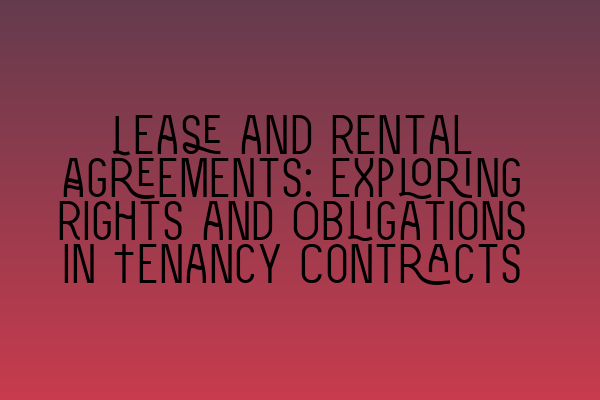Lease and Rental Agreements: Exploring Rights and Obligations in Tenancy Contracts
When it comes to leasing or renting a property, having a clear understanding of the rights and obligations outlined in a tenancy contract is crucial. Whether you are a landlord or a tenant, knowing the terms of your agreement will help ensure a smooth and mutually beneficial relationship. In this blog post, we will take an in-depth look at lease and rental agreements, exploring the rights and obligations of both parties involved.
Before we dive into the details, it’s important to note that contract law governs all lease and rental agreements. A thorough understanding of contract law principles allows the parties involved to create a fair contract that protects their interests. If you want to learn more about interpreting contractual clauses and unlocking hidden meanings, check out our related article on Interpreting Contractual Clauses: Unlocking the Hidden Meanings.
Now, let’s delve into the main components of lease and rental agreements, starting with the rights and obligations of the landlord.
Landlord’s Rights and Obligations:
1. Right to Collect Rent: The landlord has the right to receive rent from the tenant in exchange for allowing the tenant to occupy the property. The tenant’s obligation to pay rent is fundamental to the agreement.
2. Right to Enter the Property: In order to conduct necessary repairs, inspections, or show the property to potential buyers, the landlord has the right to enter the premises. However, the landlord must provide reasonable notice to the tenant and respect their privacy.
3. Obligation to Maintain the Property: The landlord is responsible for maintaining the property in a habitable condition. This includes making necessary repairs, keeping common areas clean, and ensuring that essential utilities are in working order.
To explore the various types of agreements in contract law, check out our related article on Agreements in Contract Law: Understanding Its Various Types.
Tenant’s Rights and Obligations:
1. Right to Quiet Enjoyment: The tenant has the right to peacefully enjoy the property without interference from the landlord. This includes being free from unreasonable disturbances and having the exclusive use of their rented space.
2. Right to Receive Notice: If the landlord intends to make significant changes to the tenancy agreement or terminate the tenancy, the tenant has the right to receive sufficient notice. The length of notice may vary depending on local regulations.
3. Obligation to Pay Rent On Time: The tenant is obligated to pay rent on time as stipulated in the lease agreement. Failure to pay rent may result in penalties, eviction, or legal action.
Understanding the basis of contractual exchange is vital to grasp the concept of consideration in lease and rental agreements. If you’d like to learn more about this topic, check out our related article on Essentials of Consideration: Understanding the Basis of Contractual Exchange.
Both Parties’ Rights and Obligations:
1. Mutual Obligation to Comply with the Agreement Terms: Both the landlord and tenant have a mutual obligation to adhere to the terms of the contract. This includes respecting the agreed-upon conditions, such as the duration of the tenancy, permissible use of the property, and restrictions on alterations.
2. Duty to Mitigate Damages: In the event of a breach of contract, both parties have a duty to mitigate their damages. This means taking reasonable steps to minimize any losses suffered as a result of the breach.
Now that you have a better understanding of the rights and obligations in lease and rental agreements, it’s worth mentioning that contract law can often be complex and challenging for students. Our team at SQE Contract Law specializes in simplifying complex concepts for students. Check out our related article on Contract Law Tutorials: Simplifying Complex Concepts for Students to enhance your understanding.
It’s important to note that lease and rental agreements can be terminated in various ways. If you want to learn more about the modes and consequences of terminating contracts, head over to our related article on Discharge of Contracts: Modes and Consequences Explained.
In conclusion, lease and rental agreements form the foundation of a landlord-tenant relationship. By understanding the rights and obligations involved, both parties can navigate the tenancy period more effectively. Remember, contract law is vast and can be challenging to grasp; seeking professional advice is always a wise choice.
If you need assistance with a lease or rental agreement or have any questions regarding contract law, feel free to reach out to SQE Contract Law. Our team of experienced solicitors will be happy to assist you.
